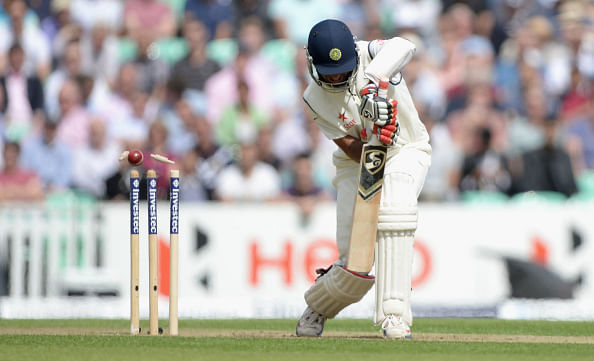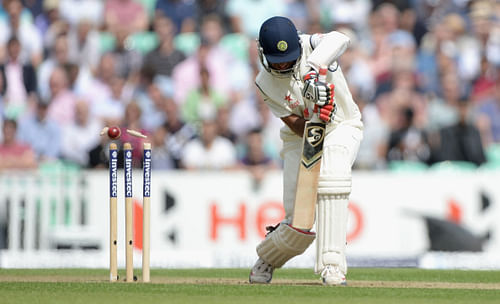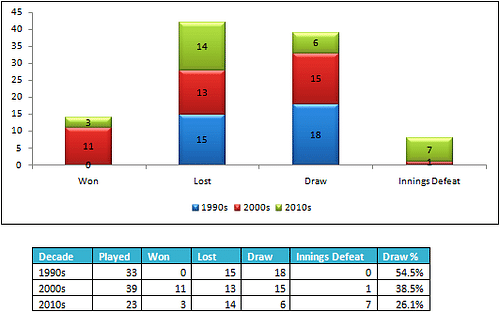
An analysis of India's overseas Test performances over the past two and a half decades

While MS Dhoni and his men were being crucified for an abject surrender during the 2014 Test series in England, I reviewed a few cricketing archives which stated that India had won only a single ‘away’ Test match during the entire 1990s decade. On closer scrutiny, I found that the ‘away’ match was the one played against Sri Lanka in Colombo, 1993.
The question which immediately cropped up was if we were being unnecessarily harsh on the current Test team, given that we went through an entire decade without a single overseas Test victory. This question was immediately transcended by another: did the golden decade of Indian Test cricket during the 2000s, ushered in under the captaincy of Sourav Ganguly and followed up impressively by Rahul Dravid and Anil Kumble, raise expectations to a level where even a reasonable record was considered abysmal?
In order to rationally get to the bottom of this, it was important to plot a comparative analysis of India’s Test performances across the decades. The following parameters were considered over 1990s, 2000s and 2010s (till date): Overseas (outside the subcontinent) Tests played, won, lost, drawn, innings defeat, and draw %age. The final couple of parameters were included to highlight India’s ability, over the decades, to limit damage in adverse conditions. The results are captured below:

The Golden Generation in the 2000s
There is no surprise that the 2000s are a shining beacon when it comes to India’s performance in Tests overseas; 11 Test victories, which included wins over Australia, England and South Africa, in their own backyard, were undoubtedly spectacular, coming after a decade-long drought. Although India began the decade with overseas victories against Zimbabwe (a far cry from their current team, including players like Alastair Campbell, Andy Flower, Grant Flower, Heath Streak and Henry Olonga) in Bulawayo in 2001, and West Indies in Port of Spain, 2002, I would pick the Test at Leeds win in 2002 against England, as a turning point in India’s overseas Test fortunes.
The match was an exemplary demonstration of India’s batting firepower, with 3 of India’s Big 4 making huge scores (Rahul Dravid 148, Sachin Tendulkar 193, and Sourav Ganguly 128) in a mammoth first innings total of 628. A solid bowling performance from both seamers and spinners ensured that India did not have to bat again. The final result – victory by an innings and 46 runs, would have instilled confidence that India had the ability to beat any team in their own home conditions.
As the decade progressed, India only got better. They should have had their first overseas series victory against Australia during the 2003-04 series, but a poor performance on the 5th day of the final Test at Sydney ensured that Australia managed to escape with a 1-1 draw in Steve Waugh’s final Test series. Ganguly passed on the baton to Dravid, who ensured that the overseas wins kept coming; the first overseas win against South Africa was registered in 2006, and in 2007, India secured its first overseas series win against England in 21 years.
Under the leadership of Kumble, India ran Australia close during the controversial and emotionally draining 2007-08 series, and Dhoni rounded off the decade with an overseas series victory over New Zealand in 2008-09.
The Problematic 1990s
Now that the golden decade is glorified, it is important to focus on the problematic decades, the 90s and the current phase. A key differentiator between the 90s and the 2000s was the quality of India’s fast bowling talent. Javagal Srinath and Venkatesh Prasad, India’s mainstays in the medium pace department, were good bowlers, but not consistent match-winners, even in helpful conditions. Absence of a reliable third seaming option was another reason why India struggled to capture 20 wickets of the opposition overseas.
The 2000s saw impactful performances from several medium-pacers, some of whom were around even earlier, but got their act together only during that decade. While Zaheer Khan was a mainstay for much of the decade, other medium-pacers like Irfan Pathan, Shanthakumaran Sreesanth, Ashish Nehra, Ishant Sharma, Rudra Pratap Singh, Ajit Agarkar, etc. were instrumental in several of the victories outlined earlier. So, while there is fair evidence to conclude that India was short on quality seam bowling options during the 90s, a draw percentage of 54.5% and no innings defeats speak highly of India’s batting quality during that period.
While the Big 4 only got together post the mid 90s, even earlier, batsmen like Mohammad Azharuddin, Sanjay Manjrekar, Vinod Kambli (briefly) and Tendulkar himself, ensured that strength in the batting department was not found wanting. It is indeed credible that India did not suffer the ignominy of an innings defeat even once during 33 overseas Tests during the decade.
Shambolic Recent Performances
With that in mind, when we examine the current curtailed decade/half-decade, a few disappointing facts are immediately thrown up – 14 losses in 23 overseas matches as opposed to 15 in 33 during the 90s, a draw percentage of only 26.1% and a shocking stat: 7 of the 14 losses were innings defeats. While two out of three victories during this period are memorable (against South Africa, Durban in 2010-11 and the recent victory against England at Lord’s), it does not erase the humiliation of the crushing defeats, which included 0-4 blanks against England and Australia during the 2011-12 season.
While India has continued to cultivate reasonable talent in the seam bowling department, it is the decline in quality of our Test batting which is the root cause of such huge defeats. The beginning of the decade saw the gradual exit of the Big 4 (Ganguly had retired even earlier) and the new crop – Cheteshwar Pujara, Virat Kohli, Ajinkya Rahane, Rohit Sharma, etc. do not meet the high standards laid down by their predecessors, as yet (10 years down the line, if this statement is proven wrong, I will be happy).
Before jumping the gun, and accusing the IPL of destroying young Indian Test batsmen, I will reflect on the South Africa and New Zealand series during the 2013-14 season – though we lost both the series, there were phases when India’s new batsmen indicated that they possessed the talent to handle aggressive seam bowling in overseas conditions. There are very few positives to take from the England Test series in 2014, but for the hope that this was just a major aberration in the course of India’s rebuilding process after the dismantling of their batting backbone.
To answer the question this article began with – the current Indian Test team does deserve every bit of flak currently bestowed on them, and it is not due to a hangover of the glorious 2000s. Though we did not win a single overseas Test during the 90s, the grit and determination on display manifested itself in the high draw % and no innings defeat; it is that grit which has been missing during the 2010s – 7 innings defeats out of a total of 14 losses highlight the tendency to surrender as soon as the going gets tough.
The current batting talent, though perhaps not at par with the Big 4, is still good, and with an improved temperament, and an infusion of grit, can still resurrect the team. With the Australian series looming large, the Indian team needs to forget the recent horror-show, and draw inspiration from the previous decade, where no overseas challenge seemed unsurmountable.